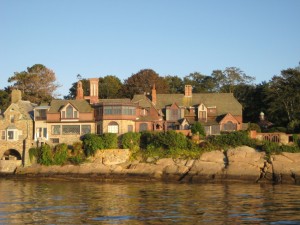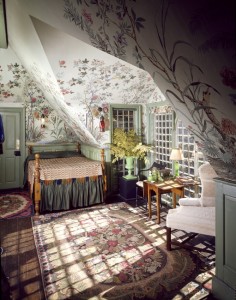Behind the velvet rope: Revealing process with museum tours and programs
13 August 2014 – Ken Turino
museums, The Public Historian, gender/sexuality, pulling back the curtain, historic house museums, tours
Editor’s Note: In “What I’ve Learned Along the Way: A Public Historian’s Intellectual Odyssey,” outgoing NCPH President Bob Weyeneth issued a call to action to public historians to include the public more fully in our work by “pulling back the curtain” on our interpretive process-how we choose the stories we tell. In this series of posts, we’ve invited several public historians to reflect on projects that do exactly that, assessing their successes and examining the challenges we face when we let the public in through the door usually reserved for staff.

Beauport, the Sleeper-McCann House, in Gloucester, Massachusetts, is now interpreted as the former home of a gay man, Henry Davis Sleeper. Photo credit: Historic New England
As a public historian working in a museum, Robert R. Weyeneth’s call to “lift the veil” and bring the public into the interpretive process is welcome–and necessary if we want to broaden the kinds of stories we tell. As Jennifer Pustz writes in Voices from the Back Stairs, “the influx of academically trained historians on museum staffs and the subsequent influence of social history on exhibitions and interpretation have resulted in a broader definition of authenticity that can encompass the whole truth, warts and all, and the history of all Americans.” [1]
Why, then, are many museums and historic sites so reticent to explore diverse stories? Do they fear the public’s reaction? If so, why aren’t we involving the visitor more in the process of historical interpretation?
House museums are traditionally among the most conservative and slow moving when it comes to making changes. Many historic sites think of the “velvet rope tour” as their primary program. These tours are static, a recitation of the family’s genealogy, a primer on the architecture of the house, and/or a decorative arts history. Front-line guides who provide the interpretation and narrative are often older, set in their ways–“this is always how we tell the story”–and subsequently, are reluctant to change or not sure how to deviate from the script. But tours don’t have to be “deadly.” They can instead open up the interpretive process to visitors. Historic house museums around the country are experimenting with using guided tours and programs for this purpose.
The Lower East Side Tenement Museum in New York City is among the best. Miriam Bader, Director of Education, and her team, on both regular and specialty tours, discuss with visitors how historians learn about the past. Several tours are advertised as tours and discussions, such as “Hard Times” and “Sweatshop Workers,” which use specific apartments to discuss themes arising from the tour. On the tours, visitors see primary source documents, such as census records, and artifacts, including the building itself, to piece together history. The documents and artifacts help visitors make sense of what they are seeing. Visitors learn how historians know what we know and share their stories and experiences to make connections with the past. The popularity of the museum points not only to the fact that much of the public can relate to the immigrant story but that these specific kinds of tours make the story both more engaging and meaningful.

The Belfry Chamber at Beauport, former home of one of America’s first professional interior designers.
At one Historic New England site, we are entering into discussions with visitors about the process of historical interpretation on tours–and why we are now interpreting the site as the home of a gay man. Beauport, the Sleeper-McCann House in Gloucester, Massachusetts, was the summer home of one of America’s first professional interior designers, Henry Davis Sleeper. Sleeper, a bachelor who often came to the home with his mother, was known for his lavish entertaining. Each of the forty rooms is distinguished by a historical or literary figure, theme, color, shape, or object. No two rooms are the same, with each more visually dazzling than the last. For years when visitors asked our guides, “Was Sleeper gay?” their response was that he never married. Sleeper’s personal papers have disappeared (presumed destroyed), and since there was no written proof, the decision was made not to address his sexuality. In 2008 this changed when an oral history with the lover of Sleeper’s cousin identified Sleeper as a gay man.
With this new source, we decided to interpret Sleeper as a gay man, not to define him but to contextualize him. Discussing with visitors the lack of conclusive written evidence, the oral history provides a prime opportunity on the tours to illustrate the detective work historians do to understand the past. We piece together clues, respond to gaps in the historical record, and use newly discovered materials to answer questions. Staff have partnered with Boston’s The History Project, which documents and preserves Boston’s Lesbian, Gay, Bisexual, Transgender (LGBT) history, to bring members of the LGBT community to the site. With this group, we have discussed how and why the institution Historic New England has changed its interpretation based on a historian’s research, work, and interpretation of the “facts.” We have attempted to bring the public into the process of historical interpretation. Now as part of every tour, visitors learn that Sleeper was a gay man and can discuss this in terms of what Weyeneth calls the “interpretive fluidity of history.” [2]
Programs, too, can introduce visitors to the historian’s process. At the National Park Service’s Fort Vancouver in Vancouver, Washington, staff are successfully offering monthly Museum Collection Open House programs. Visitors (limited to 15) go behind the scenes inside the curation facility to examine artifacts from the collection. Each program focuses on a different topic, including dining at the fort, motherhood, hygiene, and health, up to and including present-day archeological excavations. The interpreters discuss how historians research both the artifacts and the written record. They discuss how the artifacts tell specific stories. For the Dining at Fort Vancouver program, visitors learned what the residents of Fort Vancouver ate, when they ate, where their food came from based on the recovered dinnerware and remnants of historic meals, and how historians determined this.
To be sure, the attendees of guided tours or programs are self-selected. But both are valuable venues that we public historians can use to enter into more meaty discussions with visitors on how we do what we do. These approaches could help us reach out to diverse audiences and become more relevant and inclusive. We need to continue, as Weyeneth says, to experiment and test this type of interpretation with the public and engage them in the process “to shine some light on the ’interpretation‘ at the property.” [3]
~ Kenneth C. Turino is manager of community engagement and exhibitions at Historic New England and teaches in the Tufts University Museum Studies Department.
[1] Jennifer Pustz, Voices from the Back Stairs (DeKalb: Northern Illinois University Press, 2010), 7.
[2] Weyeneth, “What I’ve Learned,” 21.
[3] Ibid., 22.




1 comment